The property consists of an 1816 Federal-style mansion named after the Granger family, a prominent political family. It remained in the Granger family for four generations. The property also features the Hubbell Law Office, a carriage house and two barns that displays nearly 100 antique carriages, sleighs and farming equipment.
Gideon Granger
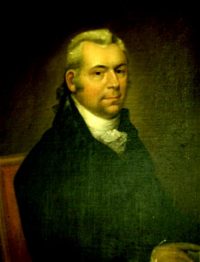
(1767-1822) Early American politician and lawyer. Born of New England Yankee stock in Suffield, Connecticut, Gideon Granger was active in state politics during the years of the American Revolution and the Constitutional Convention. A staunch supporter of Thomas Jefferson, he was named Postmaster General when Jefferson took office as President in 1800, and continued to serve under President Madison until 1813. After resigning from office, Granger moved to Canandaigua and resolved to build a Homestead that would be “unrivaled in all the nation”, from which he could administer the many land tracts he had acquired further to the west. After his arrival, Granger became influential in local affairs. Although he died in 1822, succeeding generations of the Granger family played an equally important part in the growth and development of the Canandaigua area.
Mindwell Granger
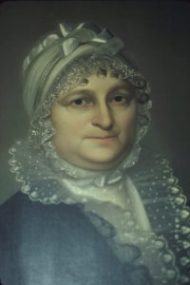
(1770-1860) Daughter of Joseph and Mindwell Pease of Suffield, CT, she married Gideon Granger on January 14, 1790. Mindwell kept the home and family running while Gideon was away in Washington, often for months at a time. Mindwell and Gideon had three sons: Ralph, Francis, and John Albert. She lived to be almost 90 years old.
Francis, Ralph & John Granger
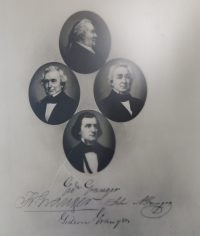
All three sons helped Gideon in building the Homestead. After its completion, Ralph moved to Ohio to handle his father’s business dealings there, becoming the first mayor of Fairport Harbor, on the shores of Lake Erie, east of Cleveland. John moved to Moscow in Livingston County, although he later returned to Canandaigua and built a house at the corner of East Gibson & Main Streets, now the Parish Administration Center of St. Mary’s Church. Francis practiced law with his father. Francis married Cornelia Rutson Van Rensselaer (1798-1823) of Utica, NY. Francis and Cornelia had three children: Cornelia, Gideon II, and an infant daughter. Cornelia (his wife) died in December of 1823 from what is believed to have been complications from childbirth. Francis never remarried, and it appears that Mindwell raised the children at the Homestead while Francis was in Albany as a State Assemblyman and Washington as the Attorney General under President Harrison.
Gideon Granger II

Gideon Granger II was the son of Francis Granger. Like his father and grandfather, he was a graduate of Yale and a practicing lawyer. Gideon II married Isaphine Pierson of Canandaigua in 1850. They had three children: Cornelia (1851-1857), Antoinette (1853-1930) and Isaphine (1859-1916). The family lived in a “small” Gothic cottage, built for them by Francis Granger, on the southeast corner of Butcher (now Granger) and Main Streets. In 1860 when Mindwell died, Francis invited Gideon II and his family to move into the main house. Francis built the North Wing at this time so Isaphine could have her children on the same floor with her.
Isaphine & Antoinette Granger
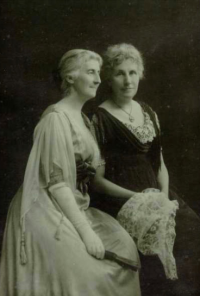
Daughters of Gideon II and Isaphine Granger, Isaphine and Antoinette, grew up in the homestead. Antoinette Granger (1853-1930) was was a very typical “tomboy” as a child. In her paper, “Memories,” presented to the Traveler’s Club, she said she had “many live pets, a large and constantly increasing family of white mice … which I took entire care of myself and a very dear canary bird … and I had a turtle and fish, and lizards and tadpoles and little frogs and a guinea pig and of course rabbits.” She goes on to talk about learning to sew on interminable patchwork, playing in the rain filled gutters on Main St., collecting tadpoles and minnows in Sucker Brook and playing in the wet basement of a friend’s house.
Isaphine Granger (1859-1916) was the quiet almost mystic sister. It is known from a letter dated December 9, 1915 written by Isaphine, that she was very sickly as a child and young woman. “It reminded us very much of my struggle against pain and great weakness as a girl and young lady . . . The best doctors here and abroad accomplished nothing for me, nor did careful diet and every care. I was often on my back for weeks and sometimes years together. I could not honestly say I was free from pain.” It is here we learn that through much suffering Isaphine was led to call upon a faith healer to relieve her pain. “Finally in August 1892, feeling it my duty to try anything whether it appealed to my reason or not, for the sake of my mother and sister, I wrote to a mental or spiritual healer in New York asking if she could help me, tho I asked without any real faith…” Apparently it helped, as she goes on to say, “Well her faith was justified and I got rid of a load of pain and fears that had been accumulating for twenty years inside of six weeks, and through the loving kindness of God, I have been as you know me ever since.”
Granger Place School for Girls

The Granger family occupied the Homestead from 1816 until the fall of 1868 when a series of tragedies occurred. Francis Granger died on August 28, 1868, and his son, Gideon, died six days later. As the home, ostensibly, failed as a safe haven for the Granger family, Isaphine (Mrs. Francis Granger) refused to live a day longer in the mansion, and she moved with her two daughters, Antoinette and Isaphine, to a nearby cottage in Canandaigua. The house remained vacant for eight years, until the lawyer, Walter Hubbell, encouraged a new school for girls to replace the defunct Ontario Female Seminary. The abandoned mansion was a perfect, central location for a girls’ school, and the Grangers sold the Homestead to Caroline Comstock and her associates for $7,500. In order to create an exceptional place of learning, Comstock and her colleagues physically changed the Homestead drastically. To the south of the central mansion, the three story Granger Place School Annex was built, designed to maximize the learning experience of the young ladies.
Walter Hubbell Law Office
Walter Hubbell came to Canandaigua in 1814 at the age of 19. He studied law under Nathaniel Howell and began to practice here. In 1822, he built a home at 164 North Main Street and erected his law office in front of his house, as was the custom.
This law office remained in use for almost 90 years. In 1910 it was moved to another site and used as a tool shed. In 1960, threatened with demolition, it was purchased and moved to the Granger Homestead grounds. It has been restored by Homestead volunteers.
During the nineteenth century, law offices like this dotted the western New York landscape. The Granger family erected two brick law offices on Main Street at each carriage drive when the house was built in 1816. Both Gideon and his son, Francis, were practicing attorneys. Attorneys received clients in the front room, and did research and writing in the other. Today, only four such structures remain in New York State: one in Pittsford, one at the Genesee Country Museum in Mumford, one at the Farmers’ Museum in Cooperstown, and this one.
Stephen Douglas, born in Vermont and educated at Canandaigua Academy, studied law under Walter Hubbell’s tutelage in this building. After practicing law for a short time here in Canandaigua, he moved to Illinois, where he was elected to the United States Senate. Known as the “Little Giant,” he became famous throughout the country for his presidential election debates with Abraham Lincoln.
West Barn
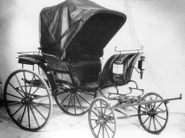
The former school annex building, the West Barn is the largest of the three barns, which houses the Carriage Museum, dates to the period when the Granger Place School occupied the site. It was constructed in 1876 and connected to the south side of the mansion, housing classrooms and a gymnasium. It was moved to the rear yard in 1907 and used as a carriage and horse barn by Antoinette and Isaphine. The building now houses the carriage collection.
Agriculture Barn

The Agriculture Barn was built in 1816 as one of a pair of matching barns. It is the oldest outbuilding on the site. It was slightly larger than the 1-1/2 story south barn. The North Barn housed farm animals and tools during the l9th century. The building was moved during the 1890s and is now used as an agricultural implement exhibit.
Pole Barn

This modern outbuilding (1960 -1962) was constructed by volunteers to accommodate the expanding carriage collection.
Gas House
The small brick building was built about 1903-04 as a gas house during the Granger Place School era. The Principal, Mr. Fairley, hoped to economize on gas costs by producing acetylene gas on the premises. Not only was it cheaper and easier to produce than coal gas, but acetylene gas provided a much brighter light. By 1906-07, however, it was out of service as city gas was reinstalled.
